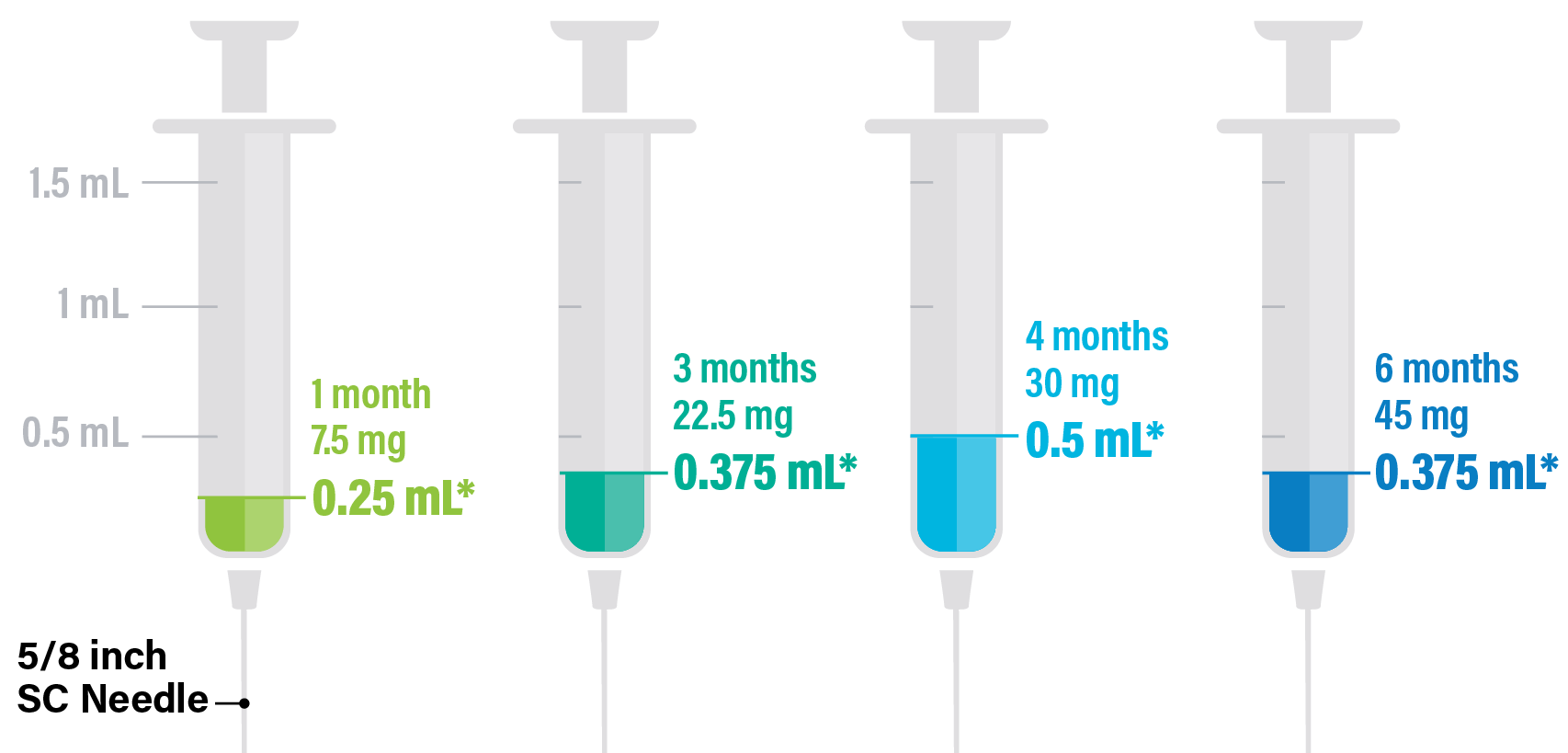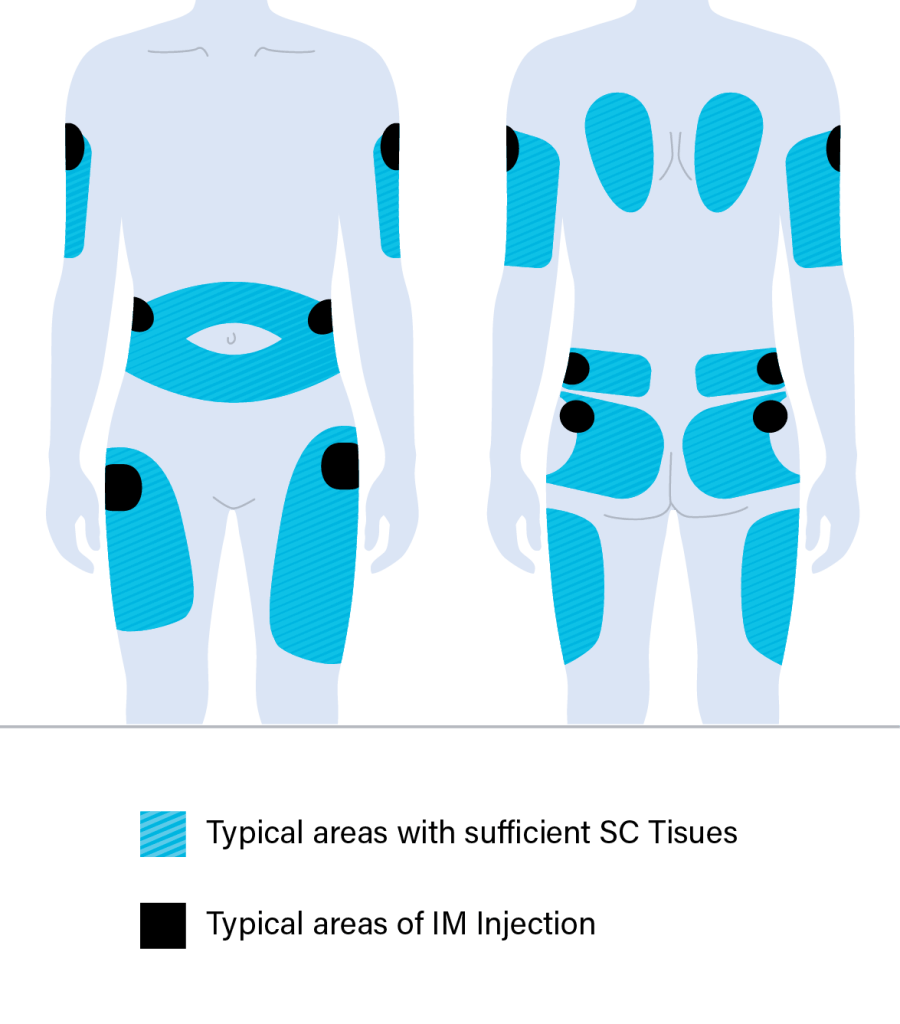CUSTOMIZABLE DOSING TO MEET YOUR PATIENTS NEEDS
Four Dosing Options
Vabrinty™ comes in 1-, 3-, 4-, and 6-month doses, allowing for as few as two injections per year—which can align with your patients’ scheduled checkups1

* Approximate dosing volume.1
SC=subcutaneous.
Vabrinty Provides Flexibility
Intramuscular (IM) vs. subcutaneous (SC) considerations for patient’s injection experience

Image source: Prettyman J, Engel L, Boldt-Houle DM, Atkinson S, Wilt W. Personalizing treatment in the delivery of care by nurses to patients with prostate cancer. Urologic Nursing. 2019;39(2):83-99.
The Benefits of Vabrinty and SC Injection3
Large Surface Area
Can be administered anywhere with sufficient SC tissue, not just the abdomen
Suitable for patients with lower muscle mass
Patient Friendly
- Minimally invasive, avoids local muscle soreness, and appropriate for patients with mobility challenges, including wheelchair users
- Flexibility in site of care, since it can be administered in semiprivate settings
Reduced Risk of Complications
- Low likelihood of bone and nerve damage and safe for patients on anticoagulants
References: 1. Vabrinty (leuprolide acetate). Prescribing Information. UroNova, Inc. 2025. 2. Sartor O. Eligard®: a new form of treatment for prostate cancer. Eur Urol Open Sci. 2006;5(18):P905-P910. 3. Prettyman J, Engel L, Boldt-Houle DM, Atkinson S, Wilt W. Personalizing treatment in the delivery of care by nurses to patients with prostate cancer. Urologic Nursing. 2019;39(2):83-99.
Important Safety Information
Vabrinty™ (leuprolide acetate) for injectable suspension is a gonadotropin releasing hormone (GnRH) agonist indicated for the treatment of advanced prostate cancer.
Vabrinty is contraindicated in patients with hypersensitivity to GnRH, GnRH agonists, or any of the components of Vabrinty.Anaphylactic reactions to synthetic GnRH or GnRH agonists have been reported in the literature. Transient increase in serum levels of testosterone during treatment may result in worsening of symptoms or onset of new signs and symptoms during the first few weeks of treatment, including bone pain, neuropathy, hematuria, bladder outlet obstruction, ureteral obstruction, or spinal cord compression. Monitor patients at risk closely and manage as appropriate.
Hyperglycemia and an increased risk of developing diabetes have been reported in men receiving GnRH agonists. Monitor blood glucose level and manage according to current clinical practice. Increased risk of myocardial infarction, sudden cardiac death and stroke has also been reported with use of GnRH agonists in men. Monitor for cardiovascular disease and manage according to current clinical practice. Androgen deprivation therapy may prolong the QT/QTc interval. Consider risks and benefits.
Convulsions have been observed in patients taking leuprolide acetate with or without a history of predisposing factors. Manage convulsions according to current clinical practice. Severe cutaneous adverse reactions (SCARs), including Stevens-Johnson syndrome/toxic epidermal necrolysis, and erythema multiforme, occurred in patients receiving Vabrinty. Monitor for and advise patients of the signs and symptoms of SCARs. May cause fetal harm.
Vabrinty may impair fertility in males of reproductive potential.
The most common injection site adverse events are transient burning and stinging, pain, bruising, and erythema. The most common systemic adverse events include mild to severe hot flashes/sweats, malaise and fatigue, weakness, myalgia, dizziness, clamminess, testicular atrophy, and gynecomastia. As with other GnRH agonists, other adverse reactions, including decreased bone density and rare cases of pituitary apoplexy have been reported.
See full Prescribing Information.
To report suspected adverse reactions, contact UroNova at 877-712-4575 or the FDA at 1-800-FDA-1088 or visit www.fda.gov/medwatch